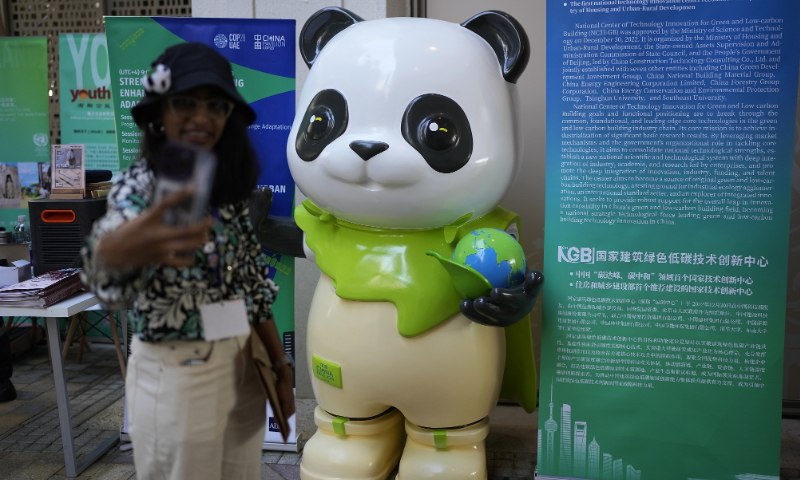
A person takes a selfie with a panda statue at the China Pavilion during the COP28 climate summit, on December 6, 2023, in Dubai, United Arab Emirates. Photo: VCG
The UN COP28 climate summit concluded in Dubai, UAE on Wednesday. At the conference, China's new energy industry and its contributions to aiding energy transformation globally were showcased, reflecting China's commitment to low-carbon development and achieving its dual carbon goals.
COP28 President Sultan Ahmed Al Jaber announced on Wednesday that parties to the UN climate summit had reached a final consensus on a "historic" climate deal, which stipulates a slew of measures to cope with climate change regarding adaptation, finance, flexibility, and fossil fuels, among others.
According to China's Ministry of Ecology and Environment, China congratulated the success of the conference, emphasizing the necessity for ambition and pragmatism in combating climate change. The goals and principles of the UNFCCC and the Paris Agreement are the cornerstone of the global climate process.
At the conference, new energy companies from China or with a Chinese background actively participated and attracted attention. For instance, the All-China Environment Federation, in partnership with LONGi Green Energy, set up the Solar+ Pavilion in the Blue Zone at COP28. Another pavilion hosted by Chinese enterprises and institutions was the Biosphere No. 3 Pavilion set up by Vanke Group.
Influenced by the UAE's net-zero emission strategy, many brands, backed by the global supply chain and particularly those with Chinese new energy upstream and downstream production bases, have established ties with the country.
For instance, the new energy vehicle brand NWTN Inc, as a representative of local UAE enterprises, appeared at COP28, demonstrating the UAE's "zero-carbon" determination. China's supply chain base has been supporting the brand.
Meanwhile, in the heart of Dubai's bustling trade and commerce landscape, the Dubai Multi Commodities Centre (DMCC) has been making significant strides in promoting sustainable development, with Chinese green enterprises playing a pivotal role.
The DMCC has attracted over 24,000 companies, with a remarkable annual growth of 15 percent in energy companies over the past five years. These figures reflect the DMCC's commitment to fostering a dynamic business environment for diverse industries, including the burgeoning new energy sector, the Global Times learned from the DMCC.
Among the prominent Chinese companies registered in the DMCC are energy giants like Sinopec, PowerChina, and Sungrow. These enterprises are at the forefront of transitioning to a low-carbon global energy sector, underscoring their critical role in shaping innovative and cleaner energy solutions. Their presence in the DMCC is not just part of business expansion but a strategic move toward sustainable energy practices that align with the UAE's green initiatives.
"The recent advancement in China's new energy industry, particularly in solar and wind power, and the country's position as the largest market for electric vehicles, has profound implications for the global energy market. This progress not only underscores China's commitment to sustainable development but also opens up strategic trade opportunities between the Middle East and East Asia across the energy spectrum," Feryal Ahmadi, COO of DMCC, told the Global Times.
"From a DMCC perspective, China's leadership in these areas presents significant collaboration potential. We are keen on exploring these opportunities to establish new trade avenues," Feryal Ahmadi said. "The UAE, with its strategic location and expertise, is well-positioned to both contribute to and benefit from this dynamic global market. Looking ahead, I foresee a growing symbiosis between our regions, shaping a more interconnected and resilient global energy landscape."




